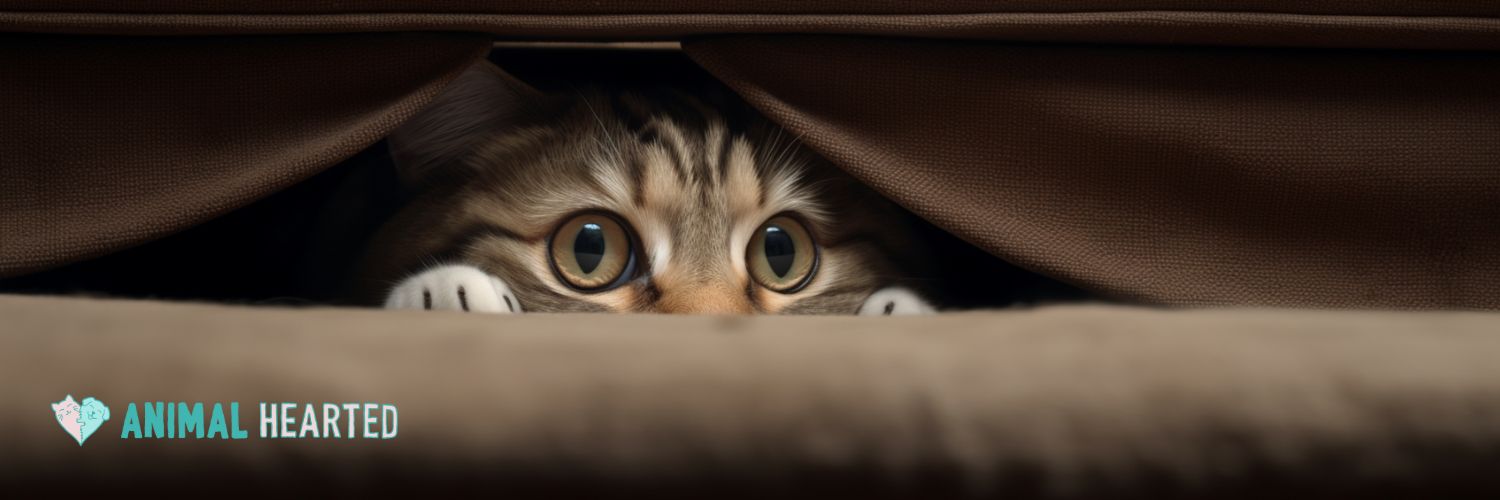shelter pets in need
Each order helps pets in need

When your cat tucks itself away into a hidden nook, it's often a natural behavior linked to their instinct for security and comfort. While it's common for cats to seek out cozy hiding spots, persistent hiding can also indicate stress, fear, or health issues.
Understanding the reasons behind your cat's retreat can help you better address their needs and coax them back into social interaction gently and effectively.
Creating an environment that feels safe to your cat is crucial in encouraging them to come out of hiding. From their perspective, the world is full of potential threats, and their behavior upon domestication rely on familiar surroundings to feel secure.
Your approach to a skittish or hidden cat should always be patient and respectful of their space — abrupt movements or force can increase their stress and prolong their hiding.
When your cat ducks out of sight and into a cozy hiding spot, it's not just for a game of hide-and-seek. They're often communicating a need or responding to their environment.
Cats hide for a myriad of reasons, and it's crucial to understand the why behind their behavior. Here are some key reasons:
Stress and fear can turn your usually sociable kitty into a recluse. Watch for these signs:

To help your cat come out of hiding, you'll want to create an environment that feels safe and consistent. Here's how you can do that with some careful adjustments to your space and routine.
Think about your home from your cat's perspective: they need spots where they feel secure to observe their world. Allocate specific areas in your household with soft bedding and low foot traffic where they can retreat to.
Furniture like shelves or even a dedicated cat tree can become a comforting refuge. To elevate the sense of security, consider using products like Feliway pheromone spray, which mimic cat's natural pheromones to promote a calming environment.
Cats thrive on a predictable schedule; it's a form of comfort all its own. Set regular times for feeding, play, and even cuddle sessions, if your cat is so inclined. This doesn't just apply to activities but also to the environment itself.
Keep changes in furniture arrangement to a minimum, as too much variation can be unsettling. Introducing catnip occasionally can also give your furry friend a soothing boost and encourage them to engage more with their surroundings.
When your cat is in hiding, a patient and gentle approach can make a big difference. It's about using the right tools and techniques to make them feel safe and secure enough to come out.
Start by using your voice to calm your cat. Speak in a soothing tone, letting them hear the familiarity of your voice.
Patience is your best friend here; sit near the hiding spot and talk gently, creating a peaceful environment. Over time, this can help reduce their stress and encourage them to venture out.
Treats can be a powerful motivator. Try offering canned tuna or other food that your cat finds irresistible. Place the treats near the hiding spot but not too close, enticing them to come to you.
You can also use their favorite cat toy to draw them out. The key is to use these items as a lure, avoiding direct interference with their hiding space. Try some of these
When your cat is hiding, it's critical to consider their overall health and well-being. You’ll want to ensure they’re not avoiding you because of illness or discomfort.
If your cat's hiding behavior is sudden or accompanied by signs of illness such as lethargy, changes in grooming habits, or vocalizations of pain, it's time to consult your veterinarian. Persistent hiding, especially when it's out of character for your cat, warrants a professional evaluation to rule out health issues.
Keep tabs on your cat’s eating and drinking habits. While in hiding, if you notice they're not coming out even for meals or their water bowl remains full, it's a signal that something might be wrong and could affect their health.
Dehydration or lack of appetite can quickly escalate, so it’s important to keep an eye on this.
When you bring a new cat home, it's all about patience and making them feel safe. It's crucial to let them adjust at their own pace and establish a sense of security in their new environment.
Set up a safe room for your new cat. This should have all the essentials: food, water, a litter box, and a few cozy hiding spots.
Keep the environment quiet to help your new cat adjust to the presence of you and your home without the pressure to explore too much too soon.
Feeding schedule should be regular and predictable. Place food bowls in quiet areas to encourage your shy friend to eat without stress.
Over time, as your adopted companion becomes more comfortable, they might start venturing out for short periods. They'll gradually acclimate to you and the rest of their new home, associating you with safety and comfort.
Leave a comment